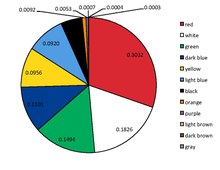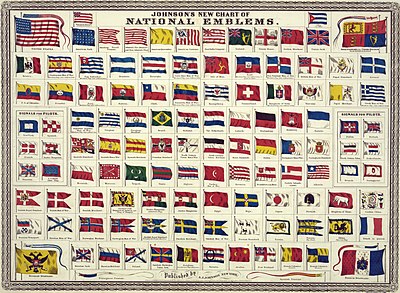Although the national flag is meant to be a unique symbol for a
country, many pairs of countries have highly similar flags. Examples
include the flags of
Monaco and
Indonesia, which differ only slightly in proportion; the flags of the
Netherlands and
Luxembourg, which differ in proportion as well as in the tint of blue used; and the flags of
Romania and
Chad, which differ only in the tint of blue.
The flags of
Ireland and
Côte d'Ivoire and the flags of
Mali and
Guinea
are (aside from shade or ratio differences) vertically mirrored
versions from each other. This means that the reverse of one flag
matches the obverse of the other. Other than horizontal mirrored flags
(like
Poland and
Indonesia) the direction in which these flags fly are crucial to identify them.
There are three colour combinations that are used on several flags in certain regions. Blue, white, and red is a
common combination in
Slavic countries such as the
Czech Republic,
Slovakia,
Russia,
Serbia,
Slovenia, and
Croatia as well as among Western nations including
Australia,
France,
Iceland,
Norway,
New Zealand, the
United Kingdom, the
Netherlands and the
United States of America. Many African nations use the
Pan-African colours of red, yellow, and green, including
Ghana,
Cameroon,
Mali and
Senegal. Flags containing red, white, and black (a subset of the
Pan-Arab colours) can be found particularly among the Arab nations such as
Egypt,
Iraq,
Syria and
Yemen.
While some similarities are coincidental, others are rooted in shared histories. For example, the flags of
Colombia, of
Ecuador, and of
Venezuela all use variants of the
flag of Gran Colombia, the country they composed upon their independence from
Spain, created by the Venezuelan independence hero
Francisco de Miranda; and the flags of
Kuwait, of
Jordan, and of
Palestine are all highly similar variants of the
flag of the Arab revolt of 1916–1918. The flags of
Romania and
Moldova
are virtually the same, because of the common history and heritage.
Moldova adopted the Romanian flag during the declaration of independence
from the USSR in 1991 (and was used in various demonstrations and
revolts by the population) and later the Moldovan coat of arms (which is
part of the Romanian coat of arms) was placed in the centre of the
flag. The
Nordic countries all use the
Nordic Cross design (
Iceland,
Denmark,
Norway,
Sweden,
Finland, in addition to the autonomous regions of the
Faroe Islands and
Åland), a horizontal cross shifted to the left on a single-coloured background. The
United States and
United Kingdom
both have red, white, and blue. This similarity is due to the fact that
the first 13 states of the U.S. were former colonies of the United
Kingdom. Also, Australia and
New Zealand share a very similar flag, which stems from their joint British heritage. Both of these flags feature the
Union Jack in one corner, both have royal blue background, and both have the
Southern Cross as a prominent feature. The only differences between these flags is that the
Australian flag has the
Commonwealth Star
below the canton, and that on the New Zealand flag, just four stars in
the Southern Cross are presented, and they are five-pointed red stars
with white borders. On the other hand, all five stars of the Southern
Cross are presented on the Australian flag, and they are white with
seven points, except for the additional smaller fifth star in the
Southern Cross which has only five points on this flag. Some
similarities to the
United States flag with the red and white stripes are noted as well such as the
flag of Malaysia and the
flag of Liberia, the latter of which was an American resettlement colony.
Many other similarities may be found among current national flags,
particularly if inversions of colour schemes are considered, e.g.,
compare the
flag of Senegal to that of
Cameroon and
Indonesia to
Poland. Also the
Flag of Italy and the
Flag of Hungary
uses the same colours, in the same order, only the direction differs
(the Italian flag is vertical and the Hungarian flag is horizontal)






